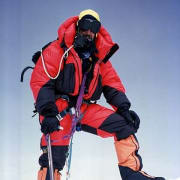Five Climbers Fall to Their Deaths on Dhaulagiri

Tragedy Strikes on Dhaulagiri
The seventh highest mountain in the world, 26,788 foot Dhaulagiri, has claimed the lives of five Russian mountaineers. It appears the fallen climbers slipped from the icy slopes of Dhaulagiri while climbing during the fall season in the Himalayas. The mountain is located in the Dhaulagiri Himal range of north-central Nepal. Rescue efforts began on Sunday when the climbers failed to return to high camp after their summit push.
A rescue team spotted the climbers’ bodies from a helicopter on Tuesday, October 8th at approximately 23,000 feet. Two climbers reached the summit of the peak, while the other three climbers had turned around before the summit attempting to get back to camp. The tragedy mirrors the fatal event last year on the same mountain when Russian climber Nadezhda Oleneva fell to her death.
Angela Benavides reported in her article, Five Russian Climbers Dead on Dhaulagiri, for ExplorersWeb that team initiated their summit bid on October 6th. They failed to check in again, and authorities were contacted. A helicopter picked up Russian climber Denis Aleksenko who, after summiting the peak on October 5th, was waiting at base camp to assist in the search. The victims were expedition leader Alexander Dusheyko, Oleg Kruglov, Vladimir Chistikov, Mikhail Nosenko, and Dmitry Shpilevoy.
Early reports suggest the climbers might have fallen at approximately 25,000 feet while traversing beneath the mountain’s summit ridge. The team may have been swept down the mountain by an avalanche, or perhaps they were attached to the same rope and fell in unison or were taken down by one falling climber. A sixth Russian climber, Valery Shamalo, had turned around above Camp 4 during the summit push, and was airlifted to a hospital in Kathmandu.
The 2024 Russian Dhaulagiri climbing team consisted of 15 climbers, and had no sherpa support beyond Base Camp, and did use supplemental oxygen on their expedition - they were alone on the mountain. This tragedy adds to a growing list of mountaineering deaths this fall climbing season - related article.
Dhaulagiri
The name “Dhaulagiri” is derived from Sanskrit, with "Dhavala" meaning white, dazzling, or beautiful, and "Giri" meaning mountain. Dhaulagiri lies northwest of the Annapurna Massif, with the Kali Gandaki Gorge—one of the deepest gorges in the world—running between these two mighty mountain ranges. Dhaulagiri massif sits close to 26,545 ft. Annapurna, and includes several subsidiary peaks, with Dhaulagiri II (25,430 ft.), Dhaulagiri III (25,311 ft.), and Dhaulagiri IV (24,993 ft.) forming a rugged series of summits around the 7th highest mountain in the world.
Dhaulagiri was first climbed on May 13, 1960, by a Swiss-Austrian expedition led by Max Eiselin. The climb was historically significant for employing the “Dhaulagiri Glacier” route, which became the standard climbing route for subsequent expeditions. The “Northeast Ridge,” is the most common climbing route today. It is a highly technical climb, featuring steep ice and snow sections, exposed ridges, high avalanche danger, and notorious weather challenges. These harsh and unpredictable weather conditions, including strong winds and heavy snowfall, render Dhaulagiri one of the more difficult 8,000-meter peaks to climb in the Himalayas. The mountain’s remote location makes rescue operations difficult, as was the case during this tragic event.
